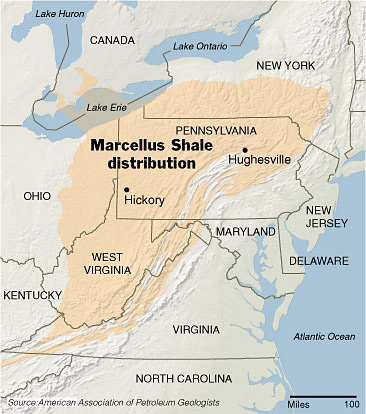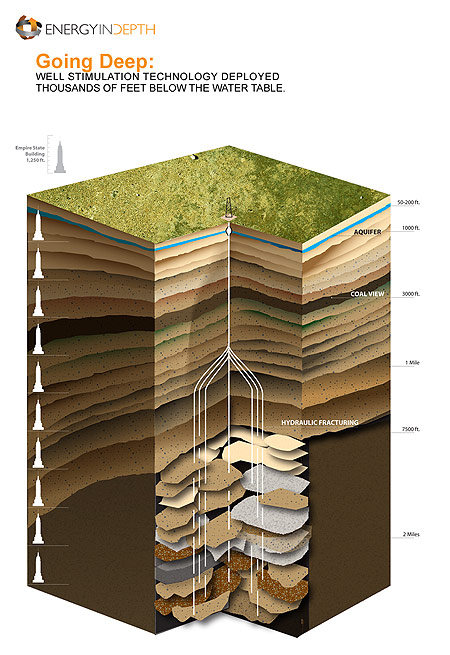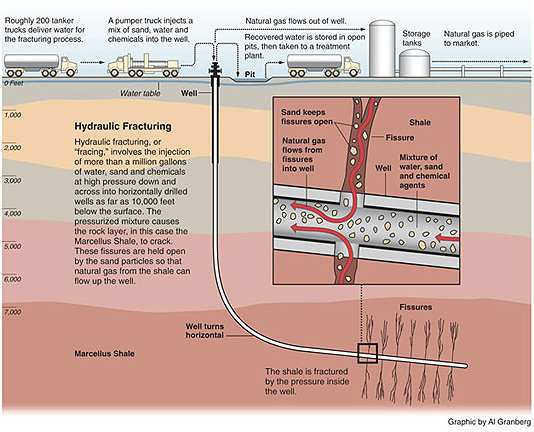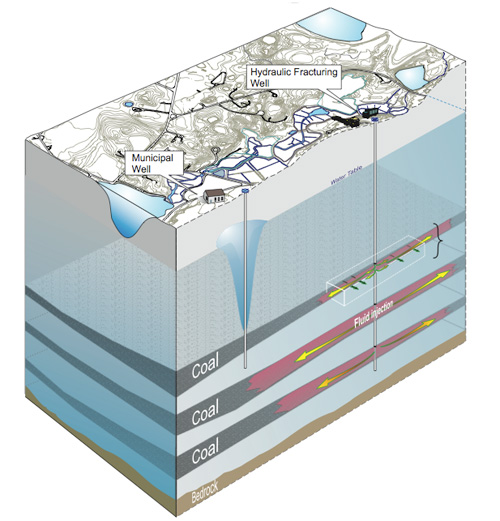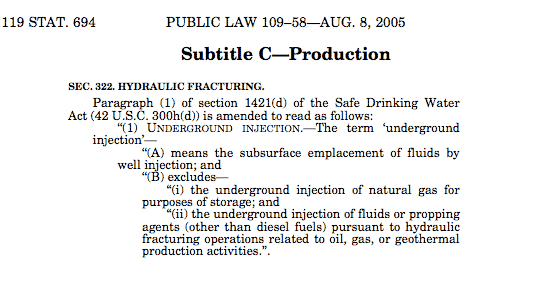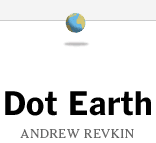This website is a crash course in fracking. At the top and bottom of these pages are links to annotated information about fracking by subject, with each page listing sorted alphabetically. Fracking (fracing, hydraulic fracturing), or hydrofracking, is a method of mining for natural gas which greatly increases the efficiency of extracting shale gas from the ground. Geological experts claim that shale beds in New York, particularly the Marcellus Shale, contain more natural gas than previously estimated.
Can we benefit by this new source of natural gas without it affecting our water and lifestyle? The diagram below, provided by Energy in Depth, an Oil and Gas Industry website, portrays a clean, quiet, well site. The reality however, as seen in the diagram provided at the bottom of this page by The Colorado Independent and Pro Publica is different.
Hydraulic fracturing uses millions of gallons of water, chemicals and lubricants. Where does all this water come from? The contents of the underground injection fluids used in fracking is a trade secret. In 2005, fracking was exempted from regulation by the Safe Drinking Water Act (1974) leaving it up to the states to monitor and regulate a rapidly increasing number of fracked wells.
The U.S. Environmental Protection Agency (EPA) was criticized in 2004 by Weston Wilson, an EPA scientist for "bad science" in this Fracking Study which led the EPA to mislead Congress to pass the Energy Policy Act of 2005 (PDF, 511 pages, 3.1MB).
Acts of Congress are often designated as public laws when they are intended to protect all members of society in areas of interaction not limited to contract and tort laws. Most U.S. Consumer Protection laws are written as Acts of Congress. Consumer Protection laws are a form of government regulation that protect the interests of consumers.
Section 322 of this Law amended the Safe Drinking Water Act (SDWA) to exempt all fracturing fluids except diesel from EPA regulations.
Read the New York Times editorial, 11/3/2009, on the Halliburton Loophole.
Federal regulators currently do not have access to a full accounting of the types and quantities of chemicals used in hydraulic fracturing fluids. On February 18, 2010 the Congressional Energy and Commerce Committee sent letters to eight companies in the fracking business requesting information on the chemicals used in fracturing fluids and the potential impact of the practice on the environment and human health. On March 18, 2010 the EPA announced that it is re-allocating $1.9 million for a comprehensive study of hydraulic fracturing. On April 7, the EPA Science Advisory Board (SAB) met for two days to provide advice on EPA’s Office of Research and Development (ORD) proposed approach to be used to frame the hydraulic fracturing study design and the areas that will be addressed by research relevant to hydraulic fracturing. Public comments were included but will not be permanently online.
The Fracturing Responsibility and Awareness of Chemicals (FRAC) Act was introduced on 6/9/2009 in the Senate to amend the Safe Drinking Water Act and reverse the hydraulic fracturing exemption. Debate on this legislation is expected later in 2010.
This legislation will not prohibit mining and drilling companies from operating, however it will remove their exemption under the Safe Drinking Water Act which allows companies to keep secret the chemicals and toxins they use in this process. Businesses involved in hydraulic fracturing projects can still continue to use a combination of water and sand or ceramic beads to increase oil and natural gas production.
This website, Fracking Resource Guide annotates evidence, opinions, and observations on whether or not the potential economic benefits for the companies doing business in the Marcellus Shale outweigh the potential harm to our other public and private interests.
Almost all of the links lead to free internet resources. There are also references to scholarly books and journal articles that your local or school librarian can help you locate. You'll find background information on fracking from reliable authors; links to companies; expert opinions; public opinions for and against fracking; government reports, politics, pending legislation and regulations; legal issues, and press reports. Use the menu at the top and bottom of these pages and the search box to navigate these resources.
Editor's Note: If we bust the myths about global warming and fossil fuels - the growing scarcity of our oil supply, and can replant lots of trees, by Freeman Dyson's estimates, a trillion, to remove all the carbon dioxide from the atmosphere now, with a lot more needed by 2050, as India, China, Brazil, etc. industrialize; then we only have to worry about methane from gas flares, and the melting of the tundra permafrost to prevent humanity from reaching the "tipping-point" of our destruction. The Earth will undoubtedly survive, but we won't. Global Warming must be addressed by all governments, NGO's, citizen activists, and corporations. Drilling Isn't Safe. (Neil Zusman, 2010-11-21.)
See my book review (4/29/2012): Wilber, Tom. Under the Surface: Fracking, Fortunes and the Fate of the Marcellus Shale. Ithaca: Cornell University Press, 2012. Print.
See: Gold, Thomas. The Deep Hot Biosphere. New York: Copernicus, 1999. Print. My article about this book is here: The Deep Hot Biosphere: The Myth of Fossil Fuels.
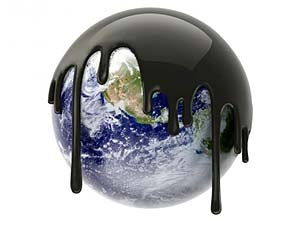
Neil Zusman (2010-08-24).
Tox Town Fact Sheet
Tox Town is designed to give you information on everyday locations where you might find toxic chemicals; non-technical descriptions of chemicals; links to selected, authoritative chemical information on the Internet; how the environment can impact human health and Internet resources on environmental health topics.
Tox Town uses color, graphics, sounds and animation to add interest to learning about connections between chemicals, the environment, and the public's health. Tox Town's target audience is students above elementary-school level, educators, and the general public. It is a companion to the extensive information in the TOXNET collection of databases that are typically used by toxicologists and health professionals.
You can explore Tox Town by selecting Neighborhoods, Location links or Chemical links.
I went to this page, For Teachers - Classroom Activities and Discussion Questions [at the High School and College level], and browsed Haz-Map by Processes and Adverse Effects for Mining and found 65 results linking to articles ranging from Hydrogen Sulfide to Diesel Exhaust and Cyanides.
See: What is the National Children's Study?
See: Household Products Database
See: Poisoned profits : the toxic assault on our children
See: Crude Oil Is Added to the Chemical Page
See: EPA | Office of Children's Health Protection
Top Three Questions
Where can I learn the facts about children's environmental health?
What can I do to protect children from environmental health risks?
Where can I find publications about children's environmental health?
U.S. Department of Health and Human Services, Center for Disease Control. July 2006. ToxFAQs™ for Hydrogen Sulfide (Ácido Sulfhídrico) In addition to methane, natural gas typically contains other hydrocarbons such as ethane, propane, butane, and pentanes. Raw natural gas may also contain water vapor, hydrogen sulfide (H2S), carbon dioxide, helium, nitrogen, and other compounds.
ATSDR serves the public by using the best science, taking responsive public health actions, and providing trusted health information to prevent harmful exposures and diseases related to toxic substances. ATSDR is directed by congressional mandate to perform specific functions concerning the effect on public health of hazardous substances in the environment. These functions include public health assessments of waste sites, health consultations concerning specific hazardous substances, health surveillance and registries, response to emergency releases of hazardous substances, applied research in support of public health assessments, information development and dissemination, and education and training concerning hazardous substances.
See: Dusty Horwitt. (2009). Drinking Water Threatened by Toxic Natural Gas and Oil Drilling Chemicals. Environmental Working Group.
In the class-action Tawney case (2009), in West Virginia, people who sold natural gas to Chesapeake and its predecessors — Triana Energy, NiSource Inc. and Columbia Natural Resources — alleged they were cheated out of some of their royalty payments, and the jury agreed.
Morgan Stanley PE committed funding to Henry Harmon’s Marcellus-shale-focused start-up Triana Energy LLC roughly a year ago, shortly before Kohlberg Kravis Roberts invested $350 million in Terrence Pegula’s Marcellus-focused East Resources.
Triana Energy is involved in the ongoing development of new energy resources in the Appalachian Basin.
Triana Energy and Marathon Oil Corporation Join Forces to Develop Marcellus Acreage
CHARLESTON, WV, February 3, 2011 Triana Energy, LLC and Marathon Oil Corporation (NYSE: MRO), through a wholly owned subsidiary, have joined forces to develop approximately 82,000 acres of Marcellus prospects in Fayette County, Pennsylvania and several counties in northern West Virginia.
Triana Energy Investments, LLC is an independent, privately held oil and gas exploration and production company headquartered in Charleston, West Virginia. Marathon is an integrated international energy company engaged in exploration and production; oil sands; integrated gas; and refining, marketing and transportation operations. Marathon, which is based in Houston, has principal operations in the United States, Angola, Canada, Equatorial Guinea, Indonesia, Iraqi Kurdistan Region, Libya, Norway, Poland, and the United Kingdom.
See: Jim Balow. "Doth Chesapeake protest too much?". The Charleston Gazette. March 12, 2009.
See: Ken Ward Jr. "Roane Gas Royalties Deal OKd, NiSource, Chesapeake to Pay $380 Million, Drop Federal Appeals." IStockAnalyst.com. Oct. 25, 2008.
A call to reduce the exorbitant bail set for non-violent civil disobedience.
Madison, W.Va. – EmmaKate Martin and Benjamin Bryant were arrested this morning while blockading the driveway to Massey Energy’s regional headquarters in Boone county, W.Va. Magistrate Snodgrass set their bails at $100,000 each for misdemeanor charges of trespassing, conspiracy to commit a misdemeanor, obstructing an officer, and littering.
Source: Climate Ground Zero
Andrew works for the Student Environmental Action Coalition's as administrative coordinator. As a student, he organized for the Michigan Student Sustainability Coalition. There are not many things he loves more than movement building.
May 17, 2010: Climate Ground Zero Activists Blockade Massey Energy Headquarters
On the morning of May 17, 2010 two activists associated with Climate Ground Zero erected a tripod tent on the driveway of Massey Energy's regional headquarters in Boone county, West Virginia. The two activists, EmmaKate Martin and Benjamin Bryant, locked themselves to the base of one of the poles. Both were arrested and charged with misdemeanor offenses of trespassing, conspiracy to commit a misdemeanor, obstructing an officer and littering. Their bails were set for $100,000 each by West Virgina Magistrate Snodgrass.
The banner they hung from the tripod read “Massey, Profits Before People & Mountains, Fight Back!” The bail was the largest ever set against any activists conducting non-violent actions against mountaintop removal in West Virginia.[56]
The Gates of Hell
This pit of fire that has been burning for 40 years looks more like something out or Mordor than Turkmenistan. But the burning crater of natural gas began shortly after a Russian drilling rig collapsed into the Underworld and no one knew what to do.
Having opened this huge poisonous gas cavern up, the atmosphere and the nearby residents in the village of Derweze decided the next logical move would be to set this huge crater on fire, and it has been burning ever since.
Here’s video of some tourists enjoying the incredible, football-field-wide hole to hell (not literally).
The Centralia Underground Coal Fire
Our former publisher and Pennsylvanian Bill Coffin used to talk about this one all the time, so I have been familiar with its existence for some time. Nevertheless, it’s completely nuts. Like the Gates of Hell, it has been burning for decades — since 1962 in fact. But unlike the Turkmenistan fire, its genesis is not so clear.
It is suspected to be a blunder by the local fire department in 1962 which had been tasked with cleaning up the local landfill, which itself sat on top of an abandoned strip mine. To accomplish this, they set the landfill on fire, apparently not an unheard of method at the time. However, the theory goes that the fire was not put out properly, and heated up veins of coal underneath the landfill, which began to smolder over time.
Eventually the reaction lit an underground fire which continued to burn, which caused little concern from local authorities until almost two decades later when in 1981, a 12-year-old boy fell into a 150-foot sinkhole which suddenly opened up in the backyard underneath his feet.
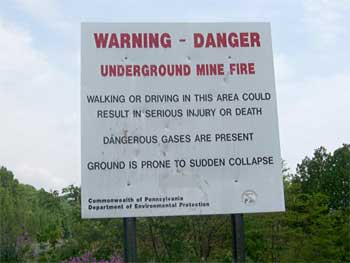
An actual sign in Centralia, PA.
Sample the Electronic Newsletter above featuring articles on industrial development of natural gas to gain a perspective on how government energy policy is crafted.
U.S. Department of Energy (DOE), Energy Information Administration. Report #:DOE/EIA-0484(2009).
Much of the increase in U.S. natural gas reserves results from expanded knowledge and exploration of shale resources.
World marketed energy consumption increases by 49 percent from 2007 to 2035 in the Reference case.
Total energy demand in non-OECD countries increases by 84 percent, compared with an increase of 14 percent in OECD countries.
NETL Oil & Natural Gas Technologies Reference Shelf. Recently released and in-demand reference materials are available directly from this page using the links on this website.
The National Energy Technology Laboratory (NETL), part of DOE’s national laboratory system, is owned and operated by the U.S. Department of Energy (DOE). NETL supports DOE’s mission to advance the national, economic, and energy security of the United States.
...the sometimes loosely governed rush to liberate this fuel from rock deposits through hydraulic fracturing, or “fracking,” has helped invigorate opponents of drilling. I agree with Christopher Helman over at Forbes, who wrote a couple of days ago that low gas prices mean there’s little to lose by holding up drilling in highly contested areas (the Marcellus Shale here in New York being the prime battle zone) while an Environmental Protection Agency scientific review is completed.
I was at the Environmental Protection Agency on Tuesday and officials there made a convincing case that the hydraulic fracturing study, due out in 2012, will clarify where real risks lie.
But campaigners who fight natural gas altogether, like anyone else immersed in the struggle over an energy policy that works for the long haul, had better come up with a real-world game plan for fostering human progress while limiting environmental risks.
Otherwise, they’ve moved from the Nimby camp to the world of the Banana (build absolutely nothing anywhere near anything).
See: Climate Co-benefits and Child Mortality Wedges
About Dot Earth
In Dot Earth, which recently moved from the news side of The Times to the Opinion section, Andrew C. Revkin examines efforts to balance human affairs with the planet’s limits.

The order prohibits the company from conducting all earth disturbance, drilling and hydro-fracturing operations throughout Pennsylvania.
The 302 violations that serve as the basis for the order were documented over a period of two years, beginning in August 2007.
Buffalo News. "Protesters picket company looking to drill in Allegany State Park". Apr 16, 2010.
AMHERST -- About 50 protesters demonstrated this afternoon in front of the headquarters of the company that wants to drill for oil in Allegany State Park.
The demonstrators, most of whom were college-age, spoke out against U.S. Energy Development Corp.'s proposal to harvest gas and oil from mineral deposits below sections of the park.
U.S. Energy Development Corporation is "one of the largest drillers in both New York and Pennsylvania."
U.S. Energy Information Administration (EIA) Energy Kids Website. Nonrenewable Natural Gas.
The main ingredient in natural gas is methane, a gas (or compound) composed of one carbon atom and four hydrogen atoms. Millions of years ago, the remains of plants and animals (diatoms) decayed and built up in thick layers. This decayed matter from plants and animals is called organic material — it was once alive. Over time, the sand and silt changed to rock, covered the organic material, and trapped it beneath the rock. Pressure and heat changed some of this organic material into coal, some into oil (petroleum), and some into natural gas — tiny bubbles of odorless gas.
Burning natural gas produces carbon dioxide which is a greenhouse gas. Greenhouse gases contribute to the "greenhouse effect."
Scientists know with virtual certainty that increasing greenhouse gas concentrations tend to warm the planet, according to the U.S. Environmental Protection Agency, Climate Change State of Knowledge.
As with other fuels, natural gas also affects the environment when it is produced, stored, and transported. Because natural gas is made up mostly of methane (another greenhouse gas), small amounts of methane can sometimes leak into the atmosphere from wells, storage tanks, and pipelines.





